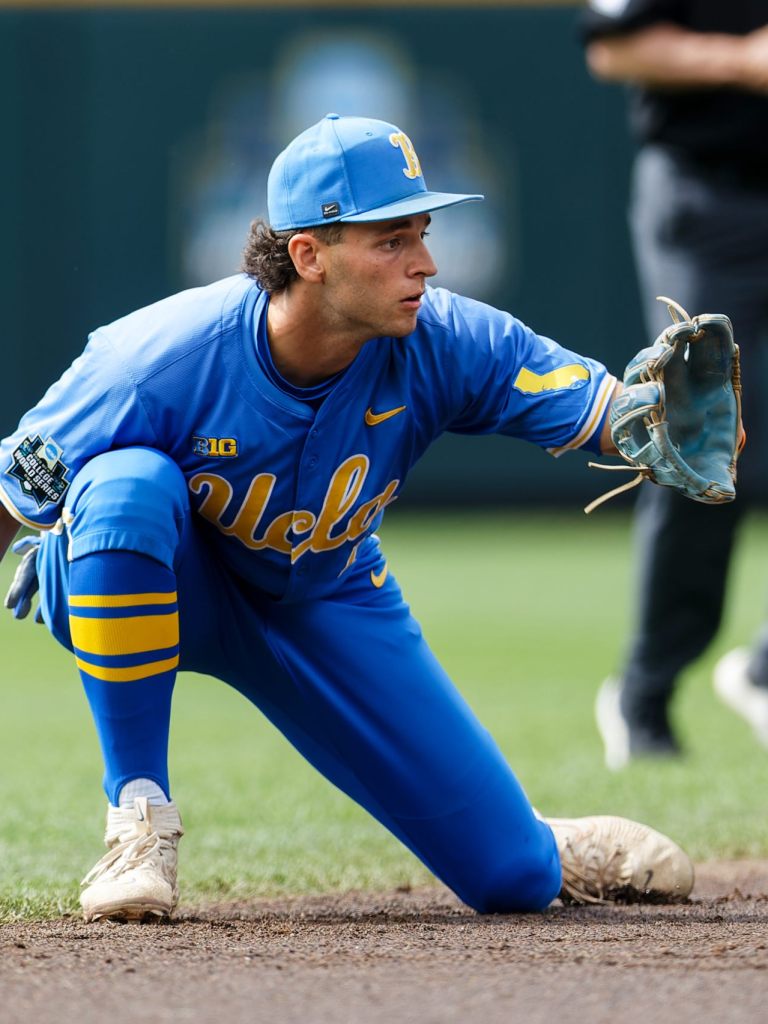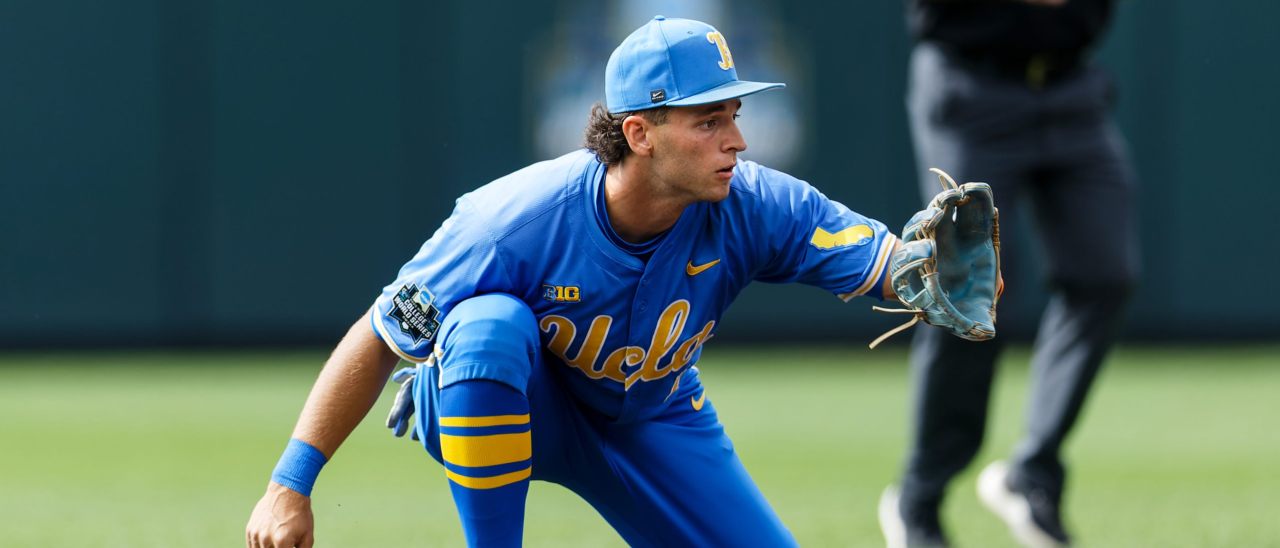Every College Player Of The Year Honored Prior To His Draft Year


Image credit: (Photo by Eddie Kelly/ ProLook Photos)
Baseball America has named a College Player of the Year every year since its founding in 1981.
No College POY was awarded in the truncated 2020 season, meaning that through the 2025 season, a total of 44 College POYs have been named.
Just six of those 44 were so honored in a season prior to their draft year. It happened most recently this year when UCLA sophomore shortstop Roch Cholowsky was named College POY.
Here is an overview of all six distinguished underclassmen—all of them sophomores—including a contemporaneous passage from their BA College Player of the Year story.
Robin Ventura, 3B, Oklahoma State
- 1987 College POY
- Batting: .428/.536/.768 (116-for-271), 21 HR, 110 RBIs, 97 R, 16 SB, 63 BB, 24 SO
- Team result: Oklahoma State lost to Stanford in CWS final
Ventura has a case as the best college baseball hitter ever. He was Freshman of the Year in 1986 and then POY as a sophomore. He was first-team All-America all three seasons at Oklahoma State, something that no other position player has ever done in his first three seasons on campus. Oh, and Ventura channeled Joe DiMaggio with a ridiculous 58-game hitting streak in his POY season of 1987.
The Streak ended on a Thursday night against Stanford. Jack McDowell, the White Sox’s No. 1 draft pick, retired him on three fly balls and a line drive to third base. Against reliever Al Osuna in the ninth inning, Ventura reached base on a hard hit-ball to second baseman Frank Carey, which after some deliberation was ruled an error.
He almost seemed glad The Streak had ended.
“I felt like it took a lot away from what this team is doing,” he said.
How it played out: The White Sox drafted Ventura 10th overall in 1988. He made his MLB debut the following September as he embarked on a 16-year career with the White Sox, Mets, Yankees and Dodgers. Ventura won six Gold Gloves at third base, made two all-star teams and smashed 294 home runs.
John Olerud, 1B/LHP, Washington State
- 1988 College POY
- Batting: .464/.558/.876 (108-for-233), 23 HR, 81 RBIs, 83 R, 1 SB, 50 BB, 22 SO
- Pitching: 15-0, 2.49 ERA, 19 GS, 123 IP, 100 H, 39 BB, 113 SO
- Team result: Washington State eliminated at Fresno West I regional
The NCAA named its two-way player of the year award after Olerud—recent winners include Paul Skenes, Spencer Schwellenbach and Jac Caglianone!—based on Olerud’s epic 1988 POY season.
The 6-foot-4, 190-pound sophomore lefthander became the first collegian ever to reach double figures in wins and hit 20 or more home runs in the same year.
Olerud led the Pacific-10 Conference Northern Division in six of nine offensive categories, running away with the triple crown. And he topped pitchers in wins, innings and strikeouts, while finishing second in ERA.
How it played out: Prior to his junior year, Olerud suffered a brain aneurysm and played an abbreviated season in 1989. The Blue Jays gambled on his talent in the third round and convinced him to sign for $575,000, the highest bonus in that draft. Olerud debuted with Toronto that September, bypassing the minor leagues entirely, as he embarked on a 17-year MLB career in which he batted .295/.398/.465 with 255 home runs and won three Gold Gloves.
Mike Kelly, OF, Arizona State
- 1990 College POY
- Batting: .376/.484/.733 (97-for-258), 21 HR, 82 RBIs, 83 R, 20 SB, 54 BB, 61 SO
- Team result: Arizona State eliminated at Tempe West II regional
A shoulder injury limited Kelly in his first year at Arizona State, when he also admits to getting caught up chasing Barry Bonds’ freshman program records, but he hit on all cylinders as a sophomore in 1990. Kelly’s physicality, power and all-world defense in center field shined through.
Of all the major leaguers he has coached, Arizona State coach Jim Brock said Kelly probably is most like Alvin Davis, who has forged a solid career with the Mariners.
“Oddibe McDowell was a great college player, but you knew his ceiling was somewhat limited by his size,” Brock said. “Barry Bonds had exceptional talent, but there were some minuses.”
How it played out: Kelly hit well as a junior—but not as well as his POY year—and went No. 2 overall to the Braves in the 1991 draft. As a professional, Kelly continued to show power and defensive prowess, but trouble hitting breaking pitches held him back. Ultimately, he spent parts of six seasons in MLB, never locking down a regular role. Kelly’s biggest opportunity came for the expansion 1998 Rays, for whom he started 56 games in the outfield.
Mark Teixeira, 3B, Georgia Tech
- 2000 College POY
- Batting: .427/.547/.772 (103-for-241), 18 HR, 80 RBIs, 104 R, 13 SB, 67 BB, 23 SO
- Team result: Georgia Tech eliminated at Atlanta super regional
Teixeira told teams he would sign out of high school only if drafted in the first round. That earned him a reputation as a tough sign and pushed him to Boston in the ninth round in 1998. No matter. Teixeira took his talents to Georgia Tech, where he starred in the Cape Cod League as a teenager and then won POY as a sophomore, showing off what would become his trademark power and patience.
Teixeira started swinging a bat as soon as he could walk, always from the right side. He was an accomplished hitter by age 10, but his dad thought it came too easily. That’s when he encouraged Mark to try switch-hitting.
“He was already playing up in age level, so I told him switch-hitting was the next step up for him to take,” his father John Teixeira said. “When he first started, he wasn’t comfortable, and he was just trying to put the bat on the ball. But I told him, ‘You need to be able to drive the ball from both sides of the plate, or it’s not worth it.’ “
How it played out: Teixeira broke his right ankle early in his junior season and missed three months. Still, the Rangers made him the top college hitter drafted when they selected him fifth overall in 2001. Teixeira spent one season in the minors and then made Texas’ Opening Day roster in 2003. He hit 30 or more homers in nine seasons and finished with 409, the seventh-highest total for any player who debuted in 2000 or later.
Anthony Rendon, 3B, Rice
- 2010 College POY
- Batting: .394/.530/.801 (89-for-226), 26 HR, 85 RBIs, 83 R, 14 SB, 65 BB, 22 SO
- Team result: Rice eliminated at Austin super regional
Rendon was a sensation at Rice. Like Robin Ventura, he won Freshman of the Year and POY in successive seasons.
“He’s got remarkable wrist action,” Rice coach Wayne Graham said. “I remember the first time he hit on our field . . . He started the second round of batting practice. I said to our coaches, ‘You want to see Hank Aaron’s wrists? There they are.’ I said, ‘Don’t mess with him.’ And we haven’t. Him and Mark Teixeira are the two best hitters I’ve seen in college baseball. Lance Berkman is right up there too, but the bat was different in those days.”
How it played out: Rendon strained his throwing shoulder in the spring of his junior year and seldom played third base. He also didn’t realize his full power potential, hitting six homers in 63 games, as opposing teams pitched around him. Rendon fell to the Nationals with the sixth pick in the 2011 draft, and he motored to Washington in April 2013. He helped drive the Nationals to a 2019 World Series championship but has struggled to stay healthy or perform since signing with the Angels for the 2020 season.
Roch Cholowsky, SS, UCLA
- 2025 College POY
- Batting: .353/.480/.710 (89-for-252), 23 HR, 74 RBIs, 80 R, 7 SB, 45 BB, 30 SO
- Team result: UCLA eliminated at CWS with 1–2 record
Cholowsky knew from an early age that he wanted to be a Bruin. After playing third base as a freshman and enduring an uncharacteristically bad season by UCLA standards, he blossomed as a junior and helped the Bruins get back to Omaha for the first time since 2013. In the process, he became just the second shortstop ever to win the College POY award, following Clemson senior Khalil Greene in 2002.
Cholowsky is the rare college shortstop with plus pro potential on both sides of the ball. In 2026, he will try to become the first two-time College POY winner in BA history.
“He’s elite,” one scout said. “He’s a competitor, and every aspect of his game has distinct polish. Great feel for the barrel, disciplined hitter who can drive the ball all over the yard, and his actions at shortstop are as smooth as anyone’s. He’ll stick at the position and has a real chance to be a very early pick in ’26.”
